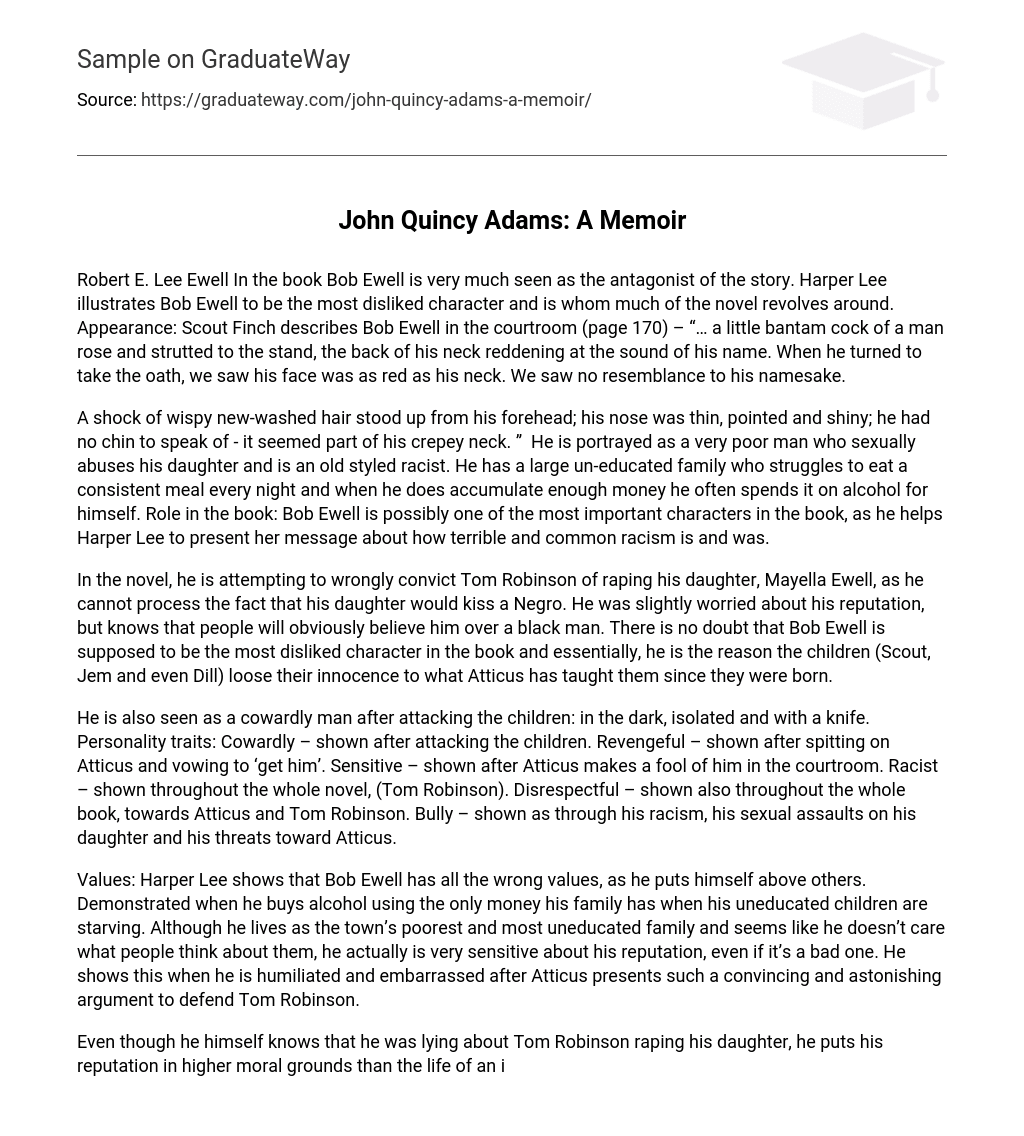Robert E. Lee Ewell In the book Bob Ewell is very much seen as the antagonist of the story. Harper Lee illustrates Bob Ewell to be the most disliked character and is whom much of the novel revolves around. Appearance: Scout Finch describes Bob Ewell in the courtroom (page 170) – “… a little bantam cock of a man rose and strutted to the stand, the back of his neck reddening at the sound of his name. When he turned to take the oath, we saw his face was as red as his neck. We saw no resemblance to his namesake.
A shock of wispy new-washed hair stood up from his forehead; his nose was thin, pointed and shiny; he had no chin to speak of – it seemed part of his crepey neck. ” He is portrayed as a very poor man who sexually abuses his daughter and is an old styled racist. He has a large un-educated family who struggles to eat a consistent meal every night and when he does accumulate enough money he often spends it on alcohol for himself. Role in the book: Bob Ewell is possibly one of the most important characters in the book, as he helps Harper Lee to present her message about how terrible and common racism is and was.
In the novel, he is attempting to wrongly convict Tom Robinson of raping his daughter, Mayella Ewell, as he cannot process the fact that his daughter would kiss a Negro. He was slightly worried about his reputation, but knows that people will obviously believe him over a black man. There is no doubt that Bob Ewell is supposed to be the most disliked character in the book and essentially, he is the reason the children (Scout, Jem and even Dill) loose their innocence to what Atticus has taught them since they were born.
He is also seen as a cowardly man after attacking the children: in the dark, isolated and with a knife. Personality traits: Cowardly – shown after attacking the children. Revengeful – shown after spitting on Atticus and vowing to ‘get him’. Sensitive – shown after Atticus makes a fool of him in the courtroom. Racist – shown throughout the whole novel, (Tom Robinson). Disrespectful – shown also throughout the whole book, towards Atticus and Tom Robinson. Bully – shown as through his racism, his sexual assaults on his daughter and his threats toward Atticus.
Values: Harper Lee shows that Bob Ewell has all the wrong values, as he puts himself above others. Demonstrated when he buys alcohol using the only money his family has when his uneducated children are starving. Although he lives as the town’s poorest and most uneducated family and seems like he doesn’t care what people think about them, he actually is very sensitive about his reputation, even if it’s a bad one. He shows this when he is humiliated and embarrassed after Atticus presents such a convincing and astonishing argument to defend Tom Robinson.
Even though he himself knows that he was lying about Tom Robinson raping his daughter, he puts his reputation in higher moral grounds than the life of an innocent African American man. Attitude towards Tom Robinson: Obviously Bob Ewell is the one that is falsely accusing Tom Robinson of raping his daughter when in fact he was the one who severely beat her. He uses Tom as an alibi to make sure his reputation of hatred and exclusion towards African Americans doesn’t get damaged. His hatred for Tom is derived from the fact that Tom is a black man who his daughter was attracted to..
Symbolism and how it relates to the world at this time: Bob Ewell was scared about putting his and his daughters reputation into dispute, because of her relationship with a black man. This shows how racist people where in those days, that many people would never want to be associated with a black man. He is the key character that Harper Lee writes about to show the ugliness and results of racism. He symbolizes a lot of people in that era, and how racism was totally acceptable.
He also symbolizes all the poor, uneducated, and ignorant types of people that lived in this time. Family/Lifestyle/Social standing: The Ewells live behind a garbage dump, which was originally a Negro cabin and are clearly extremely poor demonstrated when Bob Ewell attains a license to hunt when it is not the correct hunting season. “Every town the size of Macomb had families like the Ewells. No economic fluctuations changed their status – people like the Ewells lived as guests of the county in prosperity as well as in the depths of a depression.
No truant officers could keep their numerous offspring in school; no public health officers could free them from congenital defects, various worms, and the diseases indigenous to filthy surroundings”. Scout points out about their social standing and type of family they are. Nobody knows actually knows how many children there are living with the Ewells and as says by Scout “they give the dump a thorough gleaning everyday” to look for food and other resources that may be useful. Other quotes: “ I seen that black nigger yonder ruttin’ my Mayella! (Page 173) This comment in itself shows how un-educated, politically incorrect and simply wrong Bob Ewell is. “ Mr. finch, there’s some men you have to shoot before you say hidey to em. Even then, they aint worth the bullet it takes to shoot em… Ewell’s one of em. (Page 269) Mr. Tate said this about Bob Ewell after attacking the children. This comment shows that there are people in Maycomb that don’t agree with Bob Ewell and the jury that convicted Tom Robinson. The fact that Mr. Tate is trying to persuade that Bob Ewell’s death was a good thing, after Ewell just attacked his children, goes to show how forgiving and patient Atticus is.





